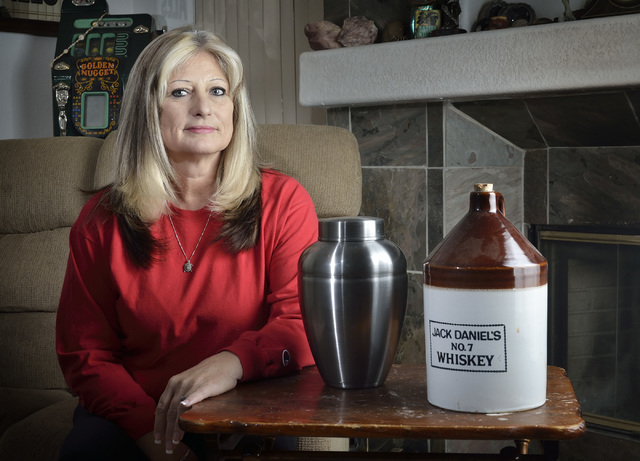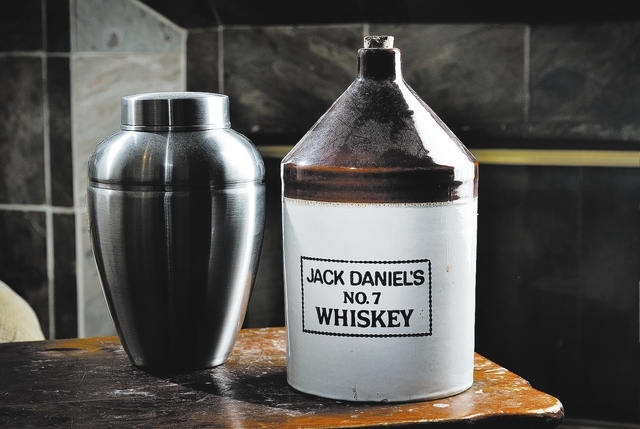Relaxed religious views help fuel popularity of cremation
A new era in how we handle The End has begun.
Raise a shot of whiskey to that fact. Teri Kerr would approve.
“My children’s father was a Jack Daniel’s man, so his ashes are in a Jack Daniel’s ceramic jug,” says Kerr, a Boulder City resident. “He was a hoarder. He kept everything, so I’ll find something and look over at him and say, ‘Seriously, did you really keep this?’ It seems funny but it’s kind of comforting.”
Seems only fair, since she gets to keep him — on the mantle, an honor that also extends to her mother in this Mormon family.
“When we were younger and went to funerals, everybody was buried, but I’ve noticed a lot more people are doing cremation,” she says. “The LDS (The Church of Jesus Christ of Latter-day Saints) has reconsidered cremation.”
It isn’t alone in condoning cremation as a method for shedding the mortal coil — one that, statistically, will soon predominate, significantly aided by a shift in religious thinking.
“Around six years ago the Catholic religion began to recognize cremation as an acceptable final disposition,” says Alan Frizzell, director of the Reno-based Cremation Societies of Nevada. “It was around that time that we saw a drastic increase for cremation.”
Figures from the Cremation Association of North America show a 9 percent leap in people choosing that option from 2007 to 2012. The group estimates that by 2016 a majority of Americans — 55 percent — will select cremation over traditional burial.
“Most of the (funeral services) we do here are cremation, and we treat the ashes exactly as we do the bodies,” says the Rev. J. Barry Vaughn, rector of Christ Church Episcopal on Maryland Parkway. “If the body is there, I would bless it. If the ashes are there, I bless them.”
Even Judaism — owing to the more liberal policies of the reform movement — contributes to the trend.
“About 40 percent of the services I officiate at are cremation now,” says Rabbi Sanford Akselrad of Congregation Ner Tamid in Henderson. “When I first arrived (in 1988), the consecrated land associated with the synagogue did not allow for the burial of cremation remains. But as we consecrated more land, we allowed for a separate area where cremation is permitted.”
Nevada is ahead of the cremation curve. In a statistical breakdown in 2012 put out by the National Funeral Directors Association, Nevada led the nation in the percentage of cremations at 74.2 percent, compared with the national average of 43.2 percent (which has climbed steadily from 50 years ago, when the rate was a mere 3.8 percent).
“In Las Vegas, there’s a lot of people for whom this is not their hometown,” says Ryan Bowen, co-owner of La Paloma Cremation and Funeral Services, which has facilities in Las Vegas and Reno. “They’ve moved here for retirement, and their children will have them cremated and sent back to them because it’s less expensive.”
The Cremation Association report puts the cost at about one-fourth that of traditional burial, the latter averaging out at $7,045 in 2012.
“In Las Vegas there is a huge range, anywhere from $295 for the cremation to a couple of thousand dollars,” Frizzell says. “For that, we would take them to church, there would be a full embalming, the body would be laid out for viewing and presentation with a ceremony, with the final disposition being the cremation itself.”
Environmental awareness also influenced the shift, with people increasingly concerned with both the land consumed by cemeteries, as well as what is being lowered into Mother Earth.
“Most of the caskets are metal, and these things don’t ever biodegrade,” Bowen says.
Yet a major factor has been the relaxation of religious restrictions that once condemned cremation as an affront to the dignity of the body — and to God.
“There was a belief at one time that you should maintain the integrity of the body, that the Christian hope is not the immortality of the soul, but the resurrection of the body,” Vaughn says. “But if you believe God can raise us, there’s no reason God can’t raise us from the ashes as well as from the body itself.”
While acknowledging that initial rejection of cremation was tied to tenets involving disposal of the body and resurrection — as well as biblical references to fire as a form of punishment — religious scholars have also cited historical tensions. Early Christians, they say, buried their deceased to separate them from pagans who practiced cremation. Another theory holds that it was considered outright rebellion because of hostilities with the Masons, who cremated their dead as a deliberate repudiation of the belief in resurrection.
Retaining the body didn’t necessarily equate with maintaining the body as sacrosanct.
“The saints’ bodies were often dismembered in the Middle Ages when people would take a finger because it was thought of as a physical connection with the saint, and through that with God,” Vaughn says.
While citing both financial and environmental reasons as part of the turn toward cremation now, Vaughn says the practice still echoes church history.
“More and more churches are adding columbariums, places where the ashes of the deceased can be placed,” Vaughn says. “This is really an extension of an ancient tradition. If you go back to churches in Europe and the Middle East, the faithful were buried in a church yard or even under the church itself.”
Accepting — and adapting to — a changing world drove the new attitude among Mormons, says Bowen, who is a member of the Mormon church.
“There’s been a breaking away from tradition,” Bowen says. “When they became a worldwide church, there are so many countries with a 90 to 99 percent cremation rate that they have to accept cremation because their members are living in an area where it’s part of their lifestyle.”
Judaism’s perspective is more conflicted.
“I’ve seen a change in what people actually do, not necessarily a change in what the religion says,” said Akselrad of Ner Tamid.
Traditionally, Judaism flatly rejects cremation, considering it a desecration and an impediment to a belief in an End of Days resurrection when the body would make its way to Jerusalem.
And the symbolism of the Holocaust — in which millions of Jews were cremated in the ovens of manmade hells named Auschwitz and Dachau — provides another painfully compelling reason to reject the practice.
“In (Orthodox) Judaism, it is still forbidden, and the same in a conservative cemetery,” Akselrad says. “In the reform rabbinate, we’re taught to discourage cremation; but for families that choose cremation for their own personal reasons, most rabbis will officiate at such a ceremony.”
On March 6, Teri Kerr’s 72-year-old mother, Charlene Cruze, a Valley of Fire tour guide, died in an accident. She had chosen cremation. Her daughter obliged.
“My mom was Native American, and we had a service at La Paloma,” Kerr says. “They have a coffin that is suitable to go through the crematory. She was prepared with all the trinkets — her Native-American walking stick, her eagle feathers, everything you want in there that will melt goes in with them. And being Mormon, she also had sacred clothing on. We had Native American music. We had the Mormon bishop do it. It was a beautiful service.”
Eventually, the ashes of Kerr’s mother and husband will reach their burial destinations when the family arranges it — hers in Nelson, his in Hawaii, both at their late loved ones’ request.
Until then, they remain spiritually near and physically close to Kerr’s heart.
“I talk to them,” Kerr says. “It’s like we’re all still here.”























